
passage 永遠の一日
2015年7月25日(土)~9月13日(日)10:00-18:00/会期中無休・入場無料
ギル・イェフマン
Gil YEFMAN

《湿った骨の谷》
使用済プラスチック製袋、ワイヤー、土、植物
サイズ可変
撮影:山本糾
抵抗のための協働的創造と公共性
服部浩之
ギル・イェフマンはユダヤ人であること、そしてトランスジェンダーであるという彼自身の複数の意味での「マイノリティ」としてのアイデンティティを基底とした作品を展開している。強制収容所や大量虐殺などユダヤ人の集団的記憶として刻まれているトラウマ的出来事と、男性なのか女性なの確信が持てなかった幼少期の性的に不安定な身体的精神的経験に依拠するジェンダー問題を折り重ね、その両問題系を想起させる具体的なモチーフをもとに、マイノリティとしての現在の世界への眼差しを提示する。例えば《Human Tapestry》は、ユダヤ人の共同墓地をモチーフとし、そのイメージを小さな断片に解体して集積し、ジャガードの巨大な織物へと仕立てたものだ。一見美しい曼陀羅を思わせる反復するイメージは、細部に着目すると無数の無名の人の顔や身体で形成されていることがわかる。やわらかな手触りの織物は家内制手工業による女性の労働を想起させる一方で、そこに刻まれた図像はマイノリティへの抑圧と虐待の事実を記す。この曼陀羅的表現は、描かれない歴史を記述しようとする態度とともに、未来へ向かう生への意思を感じさせる。同時に、作品制作はイェフマンにとって自身の存在を肯定する行為という側面も強いだろう。
ところで、日本はひとつの言語を話す単一民族が暮らす国家と我々自身も捉えがちだが、例えば青森を含む北東北や北海道はかつて蝦夷(えみし)と呼ばれる人々が暮らしており、大和により征服された過去をもち、現在でもアイヌに代表される先住民族の暮らしや文化が伝承されている土地だ。沖縄も琉球王国として独自の言語と文化をもった国家であった。日本全土には在日韓国人をはじめとするディアスポラとされる人々が多数暮らしており、日常的にはあまり意識されることはないかもしれないが日本はそもそも多様な民族が生きる地と言えるだろう。
そして被征服の歴史をもつ青森県は、戦後には原子力発電所や核燃料の再処理工場が設置されるなど、日本国内において現在も抑圧と搾取を受けている土地であることも忘れてはならない。このような背景をもつ青森で、マイノリティとして生きる意思をもつギル・イェフマンが滞在制作を実施したことは、そこに暮らす我々に直接に間接に様々な気付きを与えてくれた。
イェフマンは約三ヶ月の滞在制作により《湿った骨の谷》というプロジェクトを実施した。これは、旧約聖書の一節にある預言者エゼキエルの「枯れた骨の谷」を引用し改題したものだ。エゼキエルは、世界の滅亡やその精神的な死を象徴する枯れた骨で埋め尽くされた谷の光景を予見的に見たという。それに対してイェフマンは、本作において死や滅亡とは対極に位置する「生」のヴィジョンを提示すべく「湿った骨」の谷を生み出すことを試みた。具体的には、青森に暮らす女性たちとの協働作業により、使用済みのレジ袋を収集し、それを解体し編みあげることで骨をつくっていった。編み物は元来家庭における女性の手仕事とみなされており、一方で「癒し」を与える作業療法としても取り入れられてきたものだ。イェフマン自身、アート作品の制作は若年期の彼にとってある種の癒しのような作用もあったと述べていたが[i]、実際にこの協働制作に参加することで精神の安定や癒しを得る人が少なからず存在したのも事実だ。イェフマンは、長い間家庭というプライベートな場に閉じられていた「編む」という行為を公的空間へと開き、サロンのような場を生み出した。そこで、通常は廃棄されてしまうレジ袋を創造のための素材に変換することで、積極的な「生」へと向かう態度を表明した。死を暗示する骨をこのレジ袋で編みあげ、さらにそこに植物を芽吹かせることで、乾いた骨を生命の源である水を含んだ存在へと変換していった。このサロン的創造空間において興味深かったのは、英語を達者に話す参加者はほとんどひとりもいないが、イェフマンと彼らは非常によくコミュニケーションをとり対話を楽しみ、それぞれ自主的にたくさんの「湿った骨」を精力的に生み出していったことだ。展覧会オープン後も、女性たちはサロンとなった制作スタジオに通い、思い思いの時間を過ごしつつ骨を作り続け、展示作品を常に生成変化させていった。この変化の過程もまた、このプロジェクトが生きたものであり、すでにここが生の営みの現場であることを強く印象付けた。
一方で、このプロジェクトは私たちの生活を支配する資本主義社会に対するささやかな抵抗のための創造行為と捉えることもできる。新自由主義により格差は拡大し、弱者とされる人々はより弱者になり、それによって紛争やテロが多発している。そして我々の消費行為は少しずつ地球を蝕み様々な災害を引き起こしている。しかしわたしたち一人一人が、自身の無意識の消費活動が世界の貧困と災害を助長していることを意識することはあまりないだろう。また、実際に虐げられる人々が存在すること、あるいは自分自身が虐げられている側になりうるということも、この日本においてはあまり意識されることはないだろう。イェフマンによる廃材を用い「編む」行為を介した生と創造のための公共空間は、通常は明るみに出ないマイノリティの存在に目を向け、そして我々自身の行為と世界の雑多な問題がつながっていることを暗に示す。「編む」というプライベートな営為を協働の場へと反転的に開きサロン空間を築くことは、現在の社会環境に対する再考を促し、未来を考えるための場の形成を目指すものであった。そして見えにくい存在を描き出し、聞こえにくい声を伝えることにより、イェフマンはこの社会において現在希求される新たな公共空間の可能性を提示したのだ。
[i] ギル・イェフマンへのインタビューより。(『AC2 (17号)』国際芸術センター青森、2016年)

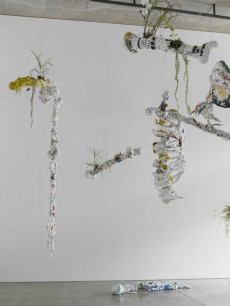
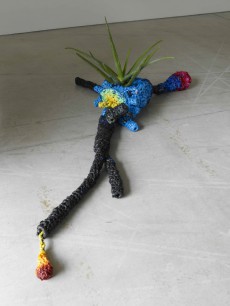

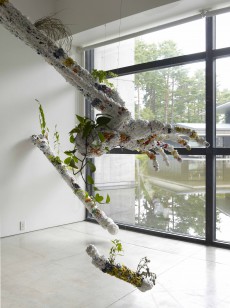

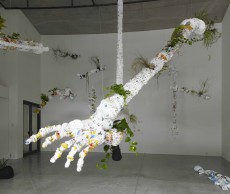
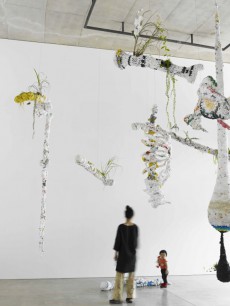

Passage: A Day in Eternity
10:00am-6:00pm, July 25 - September 13, 2015/ admission free
Gil YEFMAN
ギル・イェフマン

"The Valley Of Wet Bones"
Used plastic bags, dirt, plants, wire, size variable
photo: YAMAMOTO
Collaborative Creation and Publicness for Resistance
HATTORI Hiroyuki
Gil YEFMAN develops his works based on the multiple-definitions of his "minority" identity as Jewish and transgender. He layers traumatic events in the collective memory of the Jewish people, such as concentration camps and genocide, and gender issues resulting from his childhood experiences of being physically and mentally uncertain about his sexual orientation. Using specific motifs to address both topics, he presents his view on the current state of the world from his minority position in his artworks. In Human Tapestry, Yefman used Jewish mass graves as a motif, breaking down the images of the graves into fragments, and then weaving them into a large-scale Jacquard tapestry. The patterns of the tapestry, reminiscent of mandalas, appear beautiful at first but on closer inspection one notices that they are constructed with countless faces and body parts of anonymous individuals. While the soft tapestry suggesting feminine labour in domestic handicraft industries, the woven iconographies describe the facts of oppression and cruelty against minorities. This mandala-like expression represents Yefman's attitude in describing undepicted histories and his determination to live life, looking towards the future. Meanwhile, I assume that art making is an act of self-affirmation for Yefman.
Many people, including us, tend to perceive that Japan is a monoethnic nation with our single language. However, this is not the case. A group of people called Emishi used to live in Kita-Tohoku, including Aomori, and in Hokkaido. These regions have a history of being conquered by the Yamato people. Traditions of people native to the regions, such as the Ainu people, and their cultures and ways of living continue to be passed down today. Okinawa was historically called Ryukyu Kingdom, and it was also a separate country with its own language and culture. There are many diaspora communities, Koreans in Japan as one example, existing throughout the country. Though we may not be very conscious of it in our daily life, Japan is a place where many ethnic groups have always existed.
We must also remember that Aomori has a history of being under annexation. Aomori remains a subject of oppression and exploitation within Japan, with a nuclear power plant and a reprocessing plant built after the Second World War. The presence of Yefman, who has the resolution to live as a minority, and the work he produced during his stay in Aomori brought us many direct and indirect realizations.
Yefman undertook the project The Valley of Wet Bones during his three-month residency at Aomori Contemporary Art Centre. The project title derives from "The Valley of Dry Bones" a passage from the Old Testament, Book of Ezekiel. The passage tells that Ezekiel sees a vision of a valley filled with dry bones, symbolizing the destruction of the world and its spiritual death. As a response, Yefman attempted to create a valley of "wet bones" to present a vision of 'life' standing opposed to death and destruction. Through a collaborative process with a group of women from Aomori, they collected used plastic bags, disassembled them, then used the remains to knit the bones. Knitting has long been considered a feminine craft done within the home, and it has also recently been applied as an occupational therapy practice to aid in healing and recovery. As Yefman said that art making was some kind of healing aid for him when he was younger[1], many participants also felt that they gained mental stability and healing through the collaborative production. He took the private act of knitting out of the home and into the public domain to created a communal space referred to as a salon. Through the process of transforming the used plastic bags —objects that usually get thrown away— into a material for creation, he expressed his positive attitude towards creative production. By growing plants in the bones made from the used plastic bags, he transformed the dry bones, implying death, into water containing bodies, signifying the source of life. One of the interesting things about this gathering space was that though the majority of the participants did not speak much English, Yefman and they communicated very well, enjoyed each other's company, and proactively made a lot of the wet bones. After the exhibition started, they still came to the studio, functioning as the salon, spent their time making the bones, and continued to develop the work in the exhibition. This development process gave us a strong impression that this project had a life of its own and it was in the salon that this life was taking place.
We can also perceive this project as a humble act of creation for resistance against the capitalistic society dominating our life. Neoliberalism is creating expanding social inequality, making people in weak positions even weaker, and leading us to many conflicts and terrorism as a result. Our consumptious activities are slowly ruining our planet and causing various disasters. However, we rarely realise that our unconscious consumeristic behaviors escalate the state of the world poverty and disasters. Living in Japan, we seldom become aware that there are people somewhere being oppressed or we can be the ones to be oppressed at some point of time. Yefman initiated the communal space for life and creation through the act of knitting, using scrap materials. By doing so, he shed light on the existing minorities, that are usually concealed, and suggested the relationship between our behaviors and the issues in the world. By opening the confined, private act of knitting up to the collaborative process and creating the salon, Yefman encouraged us to reconsider the current social environment and aimed to create space for us to envision our future. Making obscured existence visible and conveying discrete voices to us, Yefman proposed possibilities for a new type of communal space needed in our society.









